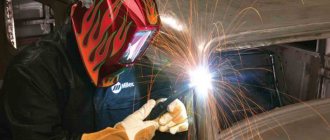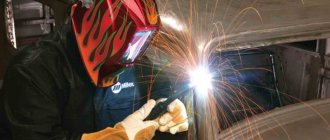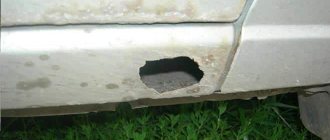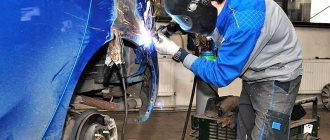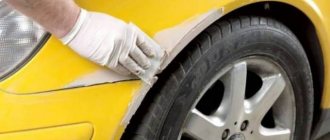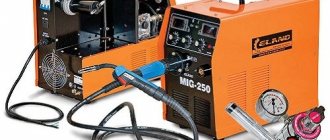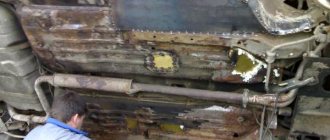Published: 04/26/2016
Rating:
With active use of the car, the body lasts for 10-15 years. It is after this time that the process of metal corrosion begins. Consequently, you will have to carry out repair work yourself or at a service station.
Welding a car body with your own hands is quite possible if you have all the necessary equipment for this.
Do-it-yourself body welding
What items are most often subject to repair?
The following parts of the machine mainly require adjustment:
- wheel fenders and arches;
- car threshold;
- bottom;
- the floor, especially in those places where there is a recess for the spare tire.
If you notice that these parts of your vehicle require repair, you need to take a welding machine and get to work.
Wheel fenders and arches most often need repairs
How to treat the body after welding
The metal must be clean before welding begins. But in its process it will inevitably be oxidized. For protection, a primary primer is used, it is called a primer.
The primer can be acidic (phosphate, reactive, there are many names, but the essence is the same, it is an etching primer) or epoxy.
The first works better against oxide residues, but protects worse in the long term. Epoxy is good as protection, you can put putty on it and the second layer of primer - filler - holds better. Putty should not be applied to an acid primer.
There is no clear choice; the master must decide, he knows better than the conditions. But then everything goes according to technology - the seams are protected with body sealant and painted or coated with protective compounds for the underbody.
It is possible to use compositions for hidden cavities. The main task is to completely block the access of moisture and oxygen to the overheated metal of the weld, the resistance of which has been lost, even if alloying additives were present in it.
How to weld the surface
Some car owners believe that such repair work can be carried out using a welding machine that operates using alternating current. In fact, using such a welding machine it is impossible to achieve a high-quality weld for the metal of the machine. In addition, it is very problematic to get with the electrode into bottlenecks of the car. It should be noted that with an alternating current device it is possible to qualitatively weld metal with a thickness of no more than 0.6 millimeters.
Due to the fact that the thickness of the metal on the machine is at least 0.8 mm, a carbon dioxide semi-automatic machine or inverter should be used. Special wire or tungsten electrodes are used as fastening material.
Preparation for welding work
First, an inverter or semi-automatic device . It is necessary to check the integrity of components and wires, since human safety depends on this. Since manipulations can be performed on metal of various thicknesses, you need to prepare 2-3 types of wire or electrodes .
Next, prepare the place where the repairs will be carried out - it needs to be dried and cleaned. Working clothes need to be put on in advance - during preparation, contamination often appears.
Semi-automatic carbon dioxide welding
Cooking using a carbon dioxide welding machine and wire will be convenient for beginners. The wire is automatically fed during metal welding, which greatly simplifies the work process. Using this method, you can carry out the following repair work on the machine:
- boiling thresholds or overcooking;
- work after straightening dents;
- strengthening patches.
Please note that if you replace carbon dioxide with argon in a semi-automatic machine, you can even weld elements made of non-ferrous metal.
Automatic carbon dioxide semi-automatic welding of car body
What type of welding to use to weld the body?
The choice of welding machine will ultimately determine the quality and speed of the work. An experienced specialist will cope with any technology, but will waste time unreasonably, and most likely simply will not engage in outdated welding methods.
For example, no one has used an oxygen-acetylene torch for a long time, although it was with its help that car bodies were repaired before the advent of modern semi-automatic machines.
Semi-automatic
The main type of welding machine in body repair is a semi-automatic machine operating in an inert gas environment. The welding method is so simple that it is accessible to any novice repairman.
Before the widespread dissemination of this technology, the art of welding as applied to body iron had to be learned a lot. Now this is available for the car owner to do independently if he wants to personally repair the body.
The essence of this welding is to feed thin copper-plated steel wire into the weld zone from a coil using an electric motor with a gearbox. One output of the electric arc supply voltage is connected to the guide rollers and the nozzle through which the wire passes, the second - to the parts being welded.
Through the same nozzle, gas is supplied to the arc area, usually carbon dioxide from a cylinder with a reducer, which does not allow oxygen, which interferes with the clean fusion of parts. Sometimes a little argon is mixed with carbon dioxide to obtain better seams.
When you press the button located on the torch of the welding machine, voltage is simultaneously applied to the wire, the supply is turned on and the carbon dioxide valve opens.
The mode is selected by manual or automatic adjustment of the basic welding parameters:
- arc current, reliable penetration of the seam, the so-called penetration, depends on it;
- wire feed speed, the higher the current, the greater the mass of filler metal should be;
- the flow of incoming gas is regulated by a reducer on the cylinder.
Typically, the current is set slightly higher than required, and the touch time is adjusted by the welder by the duration of the button press. A well-welded short stitch is formed without burning through thin metal.
Inverter
An inverter is a power electronic converter of high AC voltage into low DC voltage, which can be used to power the welding arc.
Sometimes there is still a misconception that an inverter is a welding machine for working with electrodes, but it is more compact and lighter than an outdated welding transformer. That is, according to the authors of the statement, a semi-automatic device is not an inverter.
In fact, this term refers only to the conversion method, and currently all welding machines, including semi-automatic machines and everything else, use this inverter principle.
This is interesting: How to unscrew a brake pipe with torn edges
The essence of the inverter is an increased conversion frequency. The physics is such that a transformer, and it must be present at least for galvanic isolation of the network and electrodes, is smaller in weight and dimensions, the higher the frequency at which it operates.
The network frequency is 50 Hz, such transformers for acceptable welding power weigh about 20 kg. The inverter usually operates at a frequency of 50-100 kHz, that is, a thousand times higher, so its transformer is almost invisible among other electronic components, and the entire device can weigh 2-3 kg.
Manual arc welding
If we talk about outdated technologies, but not yet completely obsolete, then this is manual welding with a consumable electrode coated with flux. The method works well when welding massive parts by an experienced specialist, but is completely unsuitable for body work.
Of course, there are specialists with extensive experience who can easily weld a tin can with an electrode, but in practice everyone uses a semi-automatic machine.
As a last resort, without a bulky cylinder, using flux-cored wire. But this has its drawbacks: consumables are expensive, and the quality of work is low.
Welding with inverter
An inverter is a welding machine that operates using high frequency current.
In addition, among the advantages the following can be noted:
- mobility - the device is much lighter and smaller than its analogues;
- fast welding;
- ability to work with both wire and tungsten electrodes.
This device is perfect for body repair. True, there are several shortcomings in this device. Due to dust, the inverter often fails and is relatively expensive. But welding metal with it is much simpler and easier than with an AC welding machine.
Cooking metal with an inverter is much simpler and easier
Features of car body welding
The main specificity of welding body iron is its small thickness. The car body is designed and manufactured for minimum weight, so thin rolled sheets are used, and strength is ensured by the three-dimensional design and reinforcement in the right places.
There are also massive parts, but there are not many of them, and they do not create problems during welding. Therefore, the main thing in this kind of repair is to orient the equipment, technology and experience of the contractor to work with a small thickness of steel sheet, less than a millimeter.
In the factory, spot welding is used. The body parts are compressed by the vise of the conductors, after which the welding robot, with its tongs, sets the points at which two or more sheets of metal are melted and firmly fastened.
It is difficult to implement this method during repairs, and there is no need for it. Spot welding is a typical conveyor technology.
On topic: How to degrease a body before polishing, painting and washing
The second feature is the absence of continuous seams. Under such an impact, the metal will be strongly moved and change its geometric dimensions.
If, out of ignorance and for reasons of increased strength, one side of the body is welded in this way, then it may turn out to be several centimeters shorter than the opposite one, and the body will be irreparably damaged. Therefore, they weld, simulating spot welding, with short stitches, observing the symmetry of heating the metal parts.
Preparatory stage
If welding work will take place outside the production area, the network load should be checked. To do this, you need to simultaneously turn on several powerful devices at home and measure the network readings. If, under such conditions, the indicators correspond to the norm or are close to it, you can use a semi-automatic device. If the voltage drops to 200 V, it is better to use an inverter. If the readings are less than 200 V, you cannot cook.
As for the machine itself, the metal surface should be cleaned of dust and dirt. Please note that you only need to work in protective clothing. Metal welding work requires strict adherence to safety.
We prepare the car body for welding work
How to weld a car body with a semi-automatic machine
Welding is carried out with short stitches or points (welding rivets). In the second case, a hole is drilled (usually at the site of the factory point), after which it is welded, both parts are fused and the gap is filled with metal.
If the metal is very thin, then there is no point in greatly reducing the welding current. You need to use short touches, quickly pressing the torch button, to throw the metal wire onto the sheets, not allowing them to burn out. After which it is more confident to melt the resulting thickened seam, giving it a marketable appearance and strength.
You cannot cook with glasses, especially without any protection at all, closing your eyes at the moment you press the button. It is necessary to use a “chameleon” type mask, which automatically shades when the arc is ignited and returns transparency immediately after the button is released. All processes will be perfectly visible, quality is guaranteed.
Technology
You can weld metal on a car using an intermittent or continuous weld type. As a rule, the second option is used if the elements to be connected are located end-to-end. Intermittent welding is used when there is a gap between the elements.
Sequence of work when welding the body:
- if wire is used, the machine is first charged with it;
- the required polarity of the current is set (on the burner - minus, on the clamp - plus);
- the carbon dioxide supply is connected;
- the machine is connected to the network;
- A copper tip is put on the wire and a nozzle is installed.
After this, you can begin welding the car body and other parts. Please note that the floor must be welded on both sides.
Welding a car body at home
Experts' opinion
This is how Vasily Zelenkov, a rather authoritative specialist in complex electronics, describes everything on his “Meander” channel in Yandex.Zen:
Yesterday
Good luck to everyone, probably each of you has at least once heard the phrase from a welder before welding work on the body/frame of a car, tractor, motorcycle, etc., or parts associated with it - “ disconnect the ground or battery completely
«.
This “rule” has always raised a logical question for me; For what?
I heard different answers, one claims that the battery will run out, the second claims that the battery will not only run out, but even deteriorate. There is also a version that it, in the sense of the battery, will explode.
In my attempts to find the truth, I always rested on the fact that none of the distributors of this myth knows the truth for certain, and everyone has their own truth.
Attempts to get to the bottom of the truth in dialogue with “those in the know” have always run into a reinforced concrete wall of the opponent’s absolute lack of understanding of the things he is talking about.
For everyone, absolutely everyone, the welding current somehow mysteriously gets into the car’s on-board circuits and destroys the battery.
Attempts to extract from them at least the most intelligible theory of the absolutely destructive voltage reaching the battery terminals, and even more so to explain which way the current should flow, ended with the phrase “ learn the hardware
“or “
You yourself are not a welder and therefore you won’t understand
.” That's it, no more, no less. Om is turning over in his grave!
The Internet is also filled with stupid stories that do not stand up to any criticism. All the same.
I personally have only one version, it can at least somehow explain the need for a ritual with disconnecting the battery.
Most likely, this requirement is spelled out in some paragraph of the PTB - welders who actually studied and did not play truant, confirm or refute the guess.
This requirement or recommendation is due to the fact that when welding, you can accidentally damage the electrical wiring of the car and burn it!!
If the work is carried out away from wires, then I believe that there is no need to disconnect anything.
One of the “smart” people once told me this: “ Have you heard about stray currents?” So their behavior and where they will go is impossible to predict!!!
“After this, both Ampere and Volt turned over in their graves, but this is not certain...
Yes, let them wander throughout the body wherever they want and however they want, how will they get into the camulator? The answer kills you on the spot - “ by wire”
!»
If I’m wrong, then why don’t any light bulbs burn out, or even more sensitive devices and electrical components?
I hope that at least under this article, people who know will answer whether it should be turned off, if so, why and in what cases.
And now the opinion of another specialist:
What does the price of welding at a service station depend on?
The cost of body welding, as we have already said, always depends on the complexity and volume of work, the chosen welding method, the urgency of the order and other points. But this solution has its own significant advantages, in the form of saving your own time, high-quality and efficient completion of work. In addition, many companies provide a warranty on operation . The price of argon welding, as a rule, starts at 600 rubles; muffler welding costs the least (except, of course, for small spot welding).
Most often, everything is determined by personal agreement at the service station. Thus, the price of removing and installing an engine sump is in the range from 1 to 3 thousand rubles.
Body preparation
A very important stage in restoring the body is the preparatory work. First of all, it is necessary to correctly assess the condition of the body parts.
And to do this you will have to disassemble the car:
- Dismantle the interior, completely (remove the seats, upholstery, dashboard, you may have to dismantle the doors);
- Remove the wings;
- Remove everything from the trunk;
- Remove old traces of bodywork.
As already noted, the first spots of corrosion appear on the bottom, sills and wheel arches. These are the ones you need to pay attention to first.
As for the thresholds, very often the rust is located inside them, so to assess their condition you will have to cut off the boxes (if there is corrosion on them, then this will have to be done in any case).
The second important point in the preparatory work is determining the boundaries of areas that require replacement.
If, for example, there are holes in the bottom, then you need to cut out an area with fairly good indentations, since the metal near the hole is already “infected” with corrosion.
However, you should not cut out anything that has traces of rust on the surface. In many areas, corrosion is only superficial and to eliminate it, it is enough to treat it with chemicals followed by anti-corrosion treatment.
In general, only those elements that have already rotted or that corrosion has greatly changed the structure of the metal should be replaced (they will soon rot).
It is not difficult to identify such areas; just use a screwdriver to pick at the surface and assess their condition.
After cutting out all problem areas, we prepare replacement material.
If these are external elements, then you will have to purchase the required body elements (fenders, sill boxes, and the sills themselves) from the car market.
For the bottom, if the cut out parts are small, almost any metal of the required thickness will do, but it is still better to use body metal. In the case of overall parts, it is better to purchase a new bottom.
Setting up regulators
An example is the semi-automatic device Helvi Panther 132 . It has three regulators that affect the current parameter. The two toggle switches have only two positions: “1” and “2” on the first, “min” and “max” on the second. The third one smoothly regulates the wire feed. And the speed at which the wire is fed depends on the magnitude of the current. This means that the device independently regulates the current depending on the wire feed.
Semi-automatic welding
As an example, we can give the settings of this semi-automatic machine for different thicknesses of the metal being welded. The thin sheet was “cooked” well at the settings: “1”, “max”, and the smooth adjustment was at “7”. It is better to try thick sheets on the setting: “2”, “max”, “8”.
When working with a semi-automatic machine, there may be different welding results. Depending on the current strength, you can get the following results:
The result of welding with different currents
First case
The current is too low, so the metal does not spread over the surface, and the part does not warm up, which worsens the mating. It turns out that there is no “penetration”. You will need to increase the current.
Second case
The current is correctly adjusted, the metal spreads sufficiently and heating of the part being welded is noticeable. A small metal drop is visible on the back of the sheet.
Third case
The current is greater than the permissible value. The molten drop from the wire has sank too much. On the other side there is an obvious large drop of molten metal.
Fourth case
A significant excess of the permissible current to such an extent that through burns are formed. A significant reduction in current is required until a small drop appears without burning.
